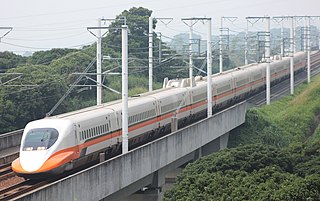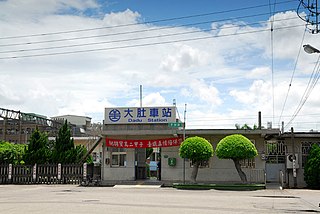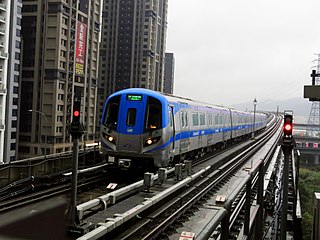
Taiwan High Speed Rail (THSR) is the high-speed railway of Taiwan consisting of one line that runs approximately 350 km (217 mi) along the west coast, from the capital Taipei to the southern city of Kaohsiung. With construction and operations managed by a private company, Taiwan High Speed Rail Corporation, which also operates the line, the total cost of the project was NT$513.3 billion in 1998. At the time it was built, this was one of the world's largest privately funded rail construction schemes. The system's technology is based primarily on Japan's Shinkansen.

Taiwan Railways Administration (TRA) is a railway operator in Taiwan. It is an agency of the Ministry of Transportation and Communications, responsible for managing, maintaining, and running conventional passenger and freight railway services on 1097 km of track in Taiwan.

The Pingtung Line is a line of the Taiwan Railway Administration West Coast line in Taiwan.

Dadu is a railway station on the Taiwan Railways Administration (TRA) West Coast line located in Dadu District, Taichung, Taiwan.

Taichung HSR is a railway and metro station in Wuri District, Taichung, Taiwan. It is served by Taiwan High Speed Rail and the Green Line of the Taichung Metro. The station is adjacent to Xinwuri Station of Taiwan Railway Administration.
The Tze-Chiang Express, also spelled "Tzu-chiang" or "Ziqiang" is a type of express train service operated by the Taiwan Railways Administration (TRA) in Taiwan. Of the five service classes operated by the TRA, the Tze-Chiang trains is the fastest category. Ticketing is done on the basis of mileage. This service is operated with 7 different trainsets: the E1000 series, the EMU1200, EMU300, TEMU1000, DR2800, DR3100, and the TEMU2000. The now-retired EMU100 was the first trainset built for this service, which was used for 30 years, terminating ordinary runs at June 15, 2009.

The Shalun Line is a branch line of the Taiwan Railways Administration (TRA) West Coast line in Tainan, Taiwan. It was built to link the Western Line to the Taiwan High Speed Rail (THSR) Tainan Station, speeding up transit times between downtown Tainan and the THSR station, with services running from Nanke railway station or Tainan TRA station to Shalun Station, next to the THSR station. The line opened on January 2, 2011.

Daqing station is a railway and metro station located in South District, Taichung, Taiwan. It is served by the Taiwan Railways Administration and Taichung Metro. The metro station opened on December 19, 2020.

The Puyuma Express is a type of railway service on Taiwan Railways (TRA) notable for using tilting trains. It began commercial service on 6 February 2013 during the Spring Festival.

The EMU800 is a series of electric multiple unit train used by the Taiwan Railways Administration (TRA).

The EMU500 series is a series of electric multiple unit passenger trains operated by Taiwan Railways Administration (TRA). The trains are built as local trains and are used throughout the country's rail network.

South Shulin is a station on the Taiwan Railways Administration West Coast line located in Shulin District, New Taipei, Taiwan. South Shulin Station is located at the intersection of Zhongshan Road and Dongxing Street.

The Green line is a rapid transit line in Taichung as part of Taichung Metro. The line was briefly opened to the public on 16 November 2020, but closed on 22 November due to faulty couplers on the trains. The line officially re-entered service on 25 April 2021, becoming Taiwan's fifth rapid transit system in operation. Two extensions, one heading east to Dakeng and the other reaching south into Changhua, are also planned.

The EMU900 series is a series of electric multiple unit passenger trains owned by Taiwan Railways Administration (TRA). Manufactured in South Korea by Hyundai Rotem, the trains are used on Local and Fast Local services, which stop at most stations. They entered service on 6 April 2021.

The EMU600 series is a series of electric multiple unit passenger trains operated by Taiwan Railways Administration (TRA). The trains are built as local trains and are used throughout the island’s rail network.

The Future is an excursion train operated by the Taiwan Railways Administration (TRA) that is composed of refurbished Chu-Kuang Express rolling stock. As of November 2020, the train only operates if reserved in advance. The Future began services on 31 December 2020.

The EMU1200 series is a series of electric multiple unit passenger trains operated by Taiwan Railways Administration (TRA). The train was originally known as the EMU200 series until all of its cars were refurbished between 2002 and 2004. It is one of the trains that are used for the Tze-Chiang Limited Express.

The Taoyuan Metro 1000 series, also referred to as Commuter Trains, are the electric multiple unit train types that are used for the all-stop Commuter services on the Taoyuan Airport MRT.

On 2 April 2021, at 09:28 NST (01:28 UTC), a Taroko Express train operated by the Taiwan Railways Administration (TRA) derailed at the north entrance of Qingshui Tunnel in Heren Section, Xiulin Township, Hualien County, Taiwan, killing 49 people and injuring at least 200 others. At the time of the accident, the train was carrying 494 passengers. The eight-carriage train derailed after colliding with a construction truck that had fallen down a slope onto the tracks north of Hualien City; the train came to rest in the tunnel, with severe damage and many casualties. The train incident was primarily due to human factors and was preventable, as an investigation from The New York Times, revealed that it was "systemic failures at a government agency" including "a culture of complacency and weak oversight", that had made the disaster possible.

The EMU3000 series is a series of electric multiple unit trains operated by the Taiwan Railways Administration (TRA). The trains are built by the Japanese company Hitachi Rail as inter-city trains and entered passenger service on 29 December 2021.




















